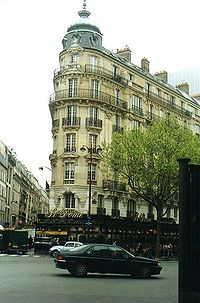
Café Society
Encyclopedia

Bright Young People
The Bright Young People was a nickname given by the tabloid press to a group of bohemian young aristocrats and socialites in 1920s London. They threw elaborate fancy dress parties, went on elaborate treasure hunts through nighttime London, and drank heavily and experimented with drugs—all of which...
who gathered in fashionable cafes and restaurants in New York, Paris, and London beginning in the late 19th century. Lucius Beebe
Lucius Beebe
Lucius Morris Beebe was an American author, gourmand, photographer, railroad historian, journalist, and syndicated columnist.-Early life and education:...
, noted American author, journalist, gourmand, and railroad enthusiast is generally credited with creating the term "café society," which he chronicled in his weekly column, This New York, for the New York Herald Tribune
New York Herald Tribune
The New York Herald Tribune was a daily newspaper created in 1924 when the New York Tribune acquired the New York Herald.Other predecessors, which had earlier merged into the New York Tribune, included the original The New Yorker newsweekly , and the Whig Party's Log Cabin.The paper was home to...
during the 1920s and 1930s.
Although members of café society were not necessarily members of The Establishment
The Establishment
The Establishment is a term used to refer to a visible dominant group or elite that holds power or authority in a nation. The term suggests a closed social group which selects its own members...
or other ruling class
Ruling class
The term ruling class refers to the social class of a given society that decides upon and sets that society's political policy - assuming there is one such particular class in the given society....
groups, they were people who attended each other's private dinners and balls, took holidays in exotic locations or at elegant resorts, and whose children tended to marry the children of other café society members.
In the United States, café society came to the fore with the end of Prohibition
Prohibition
Prohibition of alcohol, often referred to simply as prohibition, is the practice of prohibiting the manufacture, transportation, import, export, sale, and consumption of alcohol and alcoholic beverages. The term can also apply to the periods in the histories of the countries during which the...
in December 1933 and the rise of photo journalism, to describe the set of people who tended to do their entertaining semi-publicly, in restaurants and night clubs and who would include among them movie stars and sports celebrities. Some of the American night clubs and New York City restaurants frequented by the denizens of café society included El Morocco
El Morocco
El Morocco was a 20th century Manhattan nightclub frequented by the rich and famous in the 1930s and 1950s. It was famous for its blue zebra-stripe motif and its official photographer, Jerome Zerbe.-History:In 1931, John Perona , an Italian...
, the Stork Club
Stork Club
The Stork Club was a nightclub in New York City from 1929 to 1965. From 1934 onwards, it was located at 3 East 53rd Street, just east of Fifth Avenue...
, and the 21 Club
21 Club
The 21 Club, often simply 21, is a restaurant and former prohibition-era speakeasy, located at 21 West 52nd Street in New York City.-Environment:...
.
In the late 1950s the term "Jet Set
Jet set
"Jet set" is a journalistic term that was used to describe an international social group of wealthy people, organizing and participating all around the world in social activities that are unreachable to ordinary people...
" began to take the place of "café society", but "café society" may still be used informally in some countries to describe people who habitually visit coffeehouses and give their parties in restaurants rather than at home.

